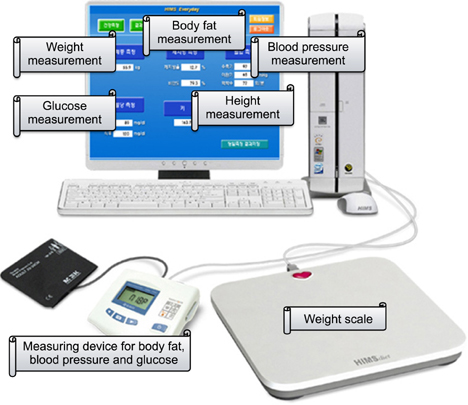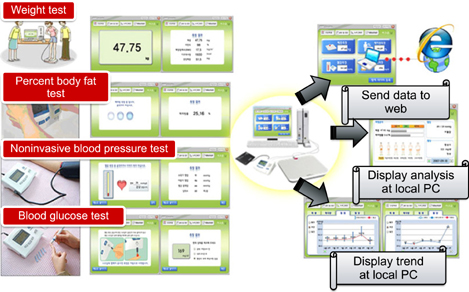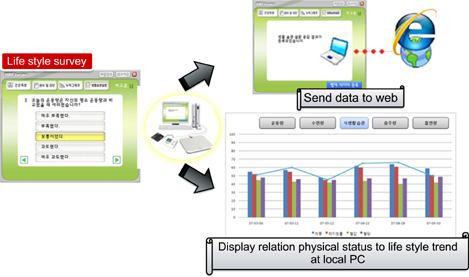Healthc Inform Res.
2012 Sep;18(3):199-207. 10.4258/hir.2012.18.3.199.
Effect of Integrated Personalized Health Care System on Middle-Aged and Elderly Women's Health
- Affiliations
-
- 1Department of Nursing, Yongin Songdam College, Yongin, Korea.
- 2Department of Nursing, Pai Chai University, Daejeon, Korea. kkyungja@pcu.ac.kr
- 3Department of Biomedical Engineering, Kyung Hee University, Seoul, Korea.
- 4Department of Nursing, Nam Seoul University, Cheonan, Korea.
- 5Department of Social and Welfare, Dongkuk University, Seoul, Korea.
- 6Department of Medical Information System, Yongin Songdam College, Yongin, Korea.
- KMID: 2229471
- DOI: http://doi.org/10.4258/hir.2012.18.3.199
Abstract
OBJECTIVES
Body weight, body mass index (BMI), body fat, and blood pressure are important indicators of a person's health. In this experimental study, we evaluated the effectiveness of an integrated personalized health care system, Health Improvement and Management System (HIMS)-everyday, which instantly provides subjects with biofeedback on their measured body weight, BMI, body fat and blood pressure using a database that stores subjects-customized information.
METHODS
The subjects of this study used the system once or twice a week for 8 weeks. We analyzed the changes in their body weight, BMI, body fat, and blood pressure according to their respective usage of the system, and analyzed the changes in their perceived health status and health promoting behavior accordingly.
RESULTS
Subjects' body weight, BMI, and blood pressure decreased significantly with respect to their individual usage of the system. Subjects who used the system more frequently showed significant improvement in their body weight, BMI, and body fat. However, subjects' perceived health status and health promoting behavior did not improve significantly.
CONCLUSIONS
The study showed that the biofeedback-based personalized health care system was effective in controlling middle-aged and elderly women' body weight, BMI, body fat, and blood pressure.
MeSH Terms
Figure
Reference
-
1. Statistics Korea. Korea statistical information service [Internet]. c2010. cited at 2012 Aug 28. Daejeon, Korea: Statistics Korea;Available from: http://kosis.kr/abroad/abroad_01List.jsp.2. Lee MS. Chronic diseases, depressive symptoms and the effects of social networks in Korean elderly population. Health Soc Sci. 2010. 27:5–30.3. Yi KH, Park JH. Real time remote management & distributed processing system by using web service based on status analysis for patients of chronic disease. Korea Comput Congr. 2007. 34(1B):508–512.4. Hill JO, Peters JC, Wyatt HR. The role of public policy in treating the epidemic of global obesity. Clin Pharmacol Ther. 2007. 81(5):772–775.
Article5. Korea Sport Science Institute. The new exercise prescription for expert. 2000. Seoul, Korea: 21 Century Education Press;91–102.6. Roh JJ. Evaluation of effectiveness for a weight control software program based on personal computer [dissertation]. 2000. Seoul, Korea: Dongduk Women's University.7. Ahn JM. The change of weight and emotion through weight control for children. J Korea Sport Res. 2003. 14(5):57–68.8. Shao GH. Establishment of an exercise prescription website based on expert system. Sport Sci. 2003. 23(1):75–77.9. Yeo NH, Park IB. Development of remodeling exercise prescription program for treatment of obesity and osteoporosis in older women. Exerc Sci. 2004. 13(3):351–366.10. Kim SS, Lee KW, Bae JJ. The development of professional computer system for exercise prescription. Korean J Phys Educ. 2004. 43(6):375–385.11. Rho SY, Choue RW. A study on the development of a computerized nutritional and health guide program based on periodic health examination at work sites. Korean J Community Nutr. 2002. 7(2):266–276.12. Han JS. A system for nutritional assessment and diagnosis of dietary intakes through internet. J Korean Soc Food Sci Nutr. 2000. 29(6):1177–1184.13. Kim KS. Prospects of ubiquitous health care. J Korean Acad Fam Med. 2007. 28:3 suppl. 89–91.14. Kang K, Han KK, Hong M. The healthcare web service using a body composition analyze. Proc Korean Soc Internet Inf. 2007. 8(2):483–486.15. Jin MH, Park SH, Park BN, Lee JO, Park JS, Lee HJ. Effect of feedback-based weight management system on body weight change. J Korean Soc Med Inform. 2008. 14(3):221–230.
Article16. Lawton MP, Moss M, Fulcomer M, Kleban MH. A research and service oriented multilevel assessment instrument. J Gerontol. 1982. 37(1):91–99.
Article17. Kim KJ. Prediction model for health promotion behaviors in middle aged men [dissertation]. 2000. Seoul, Korea: Hanyang University.18. Walker SN, Sechrist KR, Pender NJ. The health-promoting lifestyle profile: development and psychometric characteristics. Nurs Res. 1987. 36(2):76–81.19. Park MY, Kim JI, Kang HS. The relationship between health promoting behaviors and anger in elderly women. J Korean Acad Fundam Nurs. 2005. 12(3):354–361.20. Kim KA. A study on the relationship of perceived health status, ADL, and health promoting behavior of the elderly [dissertation]. 2002. Seoul, Korea: Hanyang University.
- Full Text Links
- Actions
-
Cited
- CITED
-
- Close
- Share
- Similar articles
-
- A Study on Experiences of Health Problems and Coping in Middle-aged and Elderly Women in the Community: Focusing on Focus Group Interview Approach
- Effect of Usual Source of Care on Health Behavior of the Middle Aged and the Elderly
- The Effect of an Integrated Health-Promotion Program in Middle-Aged Women
- A Comparison on Self-rated Health, Health Status, and Health Promotion Behaviors between Low income and Non-low income Elderly Women
- Belief, Knowledge, and Practice about Oral Health Care of Middle-aged Women




